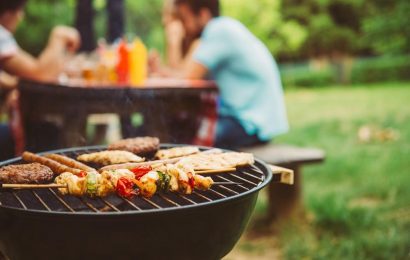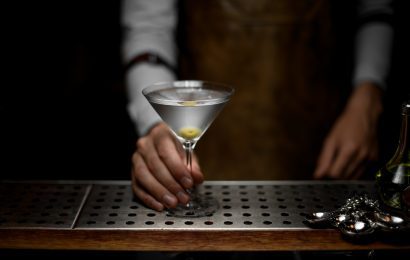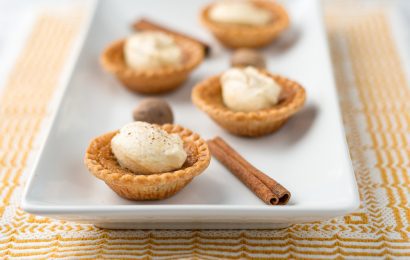Staying on track with your diabetes meal plan can be tricky during the summer months. Whether at the beach, a picnic, barbecue, or bonfire, everyone looks forward to the food almost as much as the company. But when diabetes is part of our everyday lives, it’s best to be smart regarding both food choices and portions, to keep blood sugar levels in target range. Here are the top 10 tips for “right sizing” summer food portions.
Tip #1: Shape your plate
Use the Diabetes Plate Method. Divide a 9-inch diameter plate into three sections. Fill one half of the plate with non-starchy cold and/or hot vegetables, one quarter of it with lean, grilled, or baked meat or fish (protein), and one quarter of it with grains or starches such as rice, potatoes, pasta, baked beans, bread, or corn on the cob. The sky is not the limit, meaning pile the food only to about a half inch high in each of the three sections. Add a serving of fresh fruit and 8 ounces of fat-free milk or low-fat yogurt.
Another plate system is Choose MyPlate, from the U.S. Department of Agriculture. This plate is divided into four sections, of which 40% should be vegetables, 30% grains, 20% protein, and 10% fruit, plus a dairy serving.
This tip provides a double benefit: It will balance the types of foods you eat — important for after-meal blood sugar control — and help you achieve excellent portion control. Also consider BYOP — Bring Your Own Plate. Bring some three-compartment disposable picnic plates with you to completely take the guesswork out of portioning healthy servings.
Tip #2: Estimate portion sizes
Many people find it easier to estimate healthy portion sizes using common household items. It’s fun and easy, and you don’t have to have the objects with you since their sizes are common knowledge. For example, a nine-volt battery equals one ounce of cheese, two CDs stacked equals two pancakes or one waffle, and a tennis ball equals one cup of non-starchy vegetables, pasta, or rice.
The “hand jive” system also is used to size up diabetes-friendly portions of carbohydrate, protein, and fats. You use only your hands to estimate portions. This method is summarized in “Hand Jive to Measure and Count Carbs.”
Tip #3: Wait to take seconds
After eating your balanced plate of food, wait at least 20 minutes before going back for more. It takes at least this long for our brains to know whether we have eaten enough and feel full. This tip can help with both portion control and blood sugar management. Be patient and let your brain get the message. Then, after 20 minutes, if you still are physically hungry, take one more serving of one type of food, rather than filling your plate completely.
Tip #4: Drink lots of sugar-free fluids
Fluids fill us up. Make a habit of drinking water and other sugar-free (zero-calorie) fluids before, during, and after the meal. This is easy and can work wonders with portion control. A word of caution, however, about drinking alcoholic and sugary beverages as fill-up fluids: There are hundreds of hidden calories in these drinks, and besides the risk of weight gain, they also can wreak havoc on blood sugar control.
Tip #5: Grab a healthy snack before the party
If you arrive hungry and the meal is delayed, you are more likely to overeat and eat very quickly. If your meal will be served hours from your normal meal time, eat a healthy snack to reduce ravenous hunger. High-fiber, low-sugar, low-fat choices are best, such as crackers, soup, fresh fruit, vegetable salad, granola bars, or yogurt. The snack also can prevent dangerously low blood sugar (hypoglycemia), especially if you take certain diabetes medications, including insulin.
Tip #6: Assess those apps
Picnic appetizers can be tricky! Grazing all day at the table is really navigating through a mine field of calories. A word of caution about those very high-fat spinach and French onion dips often served at barbecues and picnics: The higher the fat, the smaller your portion should be. It’s also easy to eat a lot of lighter, crispier appetizers such as chips, cheese puffs, and tortilla chips. Remember, they also are calorie-rich and have little nutritional value. For apps, remember these points.
1. Aim for a small portion on a small plate or napkin.
2. Eat mindfully and slowly, savoring every bite.
3. Sit far away from the appetizer table after making your selection.
4. Know how much food you really can eat for 150 calories.
5. Look for fresh vegetables, hummus, salsa, and baked or pita chips — or bring your own healthy appetizer.
Tip #7: Get moving
To keep from going back for second helpings and then feeling stuffed the rest of the day, gather your friends and take a walk; help clean up; play games such as softball, ring toss, bean bags, or badminton; or play in the pool or in the water at the beach. Physical activity burns calories and blood sugar, speeds up your metabolism, and is good for your digestion and mental health. You likely will be surprised at how many guests will appreciate your invitation to get out of those lawn chairs and have some fun.
Tip #8: Be savvy at the grill
Hot dogs, bratwurst, burgers, fried chicken, and ribs all are typical cookout entrees. All of these proteins are high in unhealthy saturated fats and calories, plus sodium if the meat is processed, as with hot dogs. Aim for the size of a deck of cards (cooked with any inedible parts, such as bones, removed). When meats are served on buns, be mindful of the toppings, such as cheese, guacamole, mayonnaise, and onion rings, which can add hundreds of unwanted calories. Instead, pile on mustard, ketchup, salsa, lettuce, onions, tomatoes, mushrooms, pickles, peppers, and cucumbers. Consider eating only half of a large bun. Moderation, not omission, is the key. To keep those fat calories at bay, scope out the healthy, lower-calorie choices or bring your own.
• Grilled fish such as salmon, tilapia, shrimp, scallops, and crawfish
• Veggie, soy, or black bean burgers
• Grilled chicken or turkey (without the skin)
• Burgers made with 90% to 95% lean ground turkey or beef
• Turkey or chicken sausage
• Grilled seafood kabobs skewered with summer vegetables such as peppers, onions, mushrooms, and tomatoes
Tip #9: Be picky about creamy salads
Usually, there are salads galore at picnics and barbecues — great if they’re made with fresh veggies and fruits and light dressings of olive oil and lemon, but no so good when they are higher-carb, high-fat macaroni salad, potato salad, and creamy coleslaw. Take a smaller portion, about a half cup. If salads are made with whole grains such as tabbouleh, barley, quinoa, and even corn and peas, a one-cup portion is a smart choice. And, of course, a fresh fruit salad is a dream food for weight-conscience party goers. Fruit is a carb, so if you have diabetes, count your portion in your carb budget for that meal.
Tip #10: Go slow with dessert
Often at parties, dessert is king. Sometimes there are more desserts than entrée choices. The most important tip for sugary sweets is to keep portion sizes small. A small portion means your fingers can wrap all the way around it if it’s in your hand. If it is fresh fruit or a fruit-based dessert, your portion can be larger.
Conclusion
The bottom line for having fun in the sun and enjoying picnic foods this summer: By making just a few small, easy changes, you can save hundreds of unwanted calories and a lot of unhealthy fat and salt, and you can achieve better blood sugar control.
In short, we G.E.T. what we eat:
G = Greater Health
E = Extra Longevity Leading to Extra Time to Achieve Goals
T = Terrific Energy
Want to learn more about eating well with diabetes? Read “Improving Your Recipes: One Step at a Time,” “Top Tips for Healthier Eating” and “Eating Out With Diabetes: Making the Best Menu Choices.”






